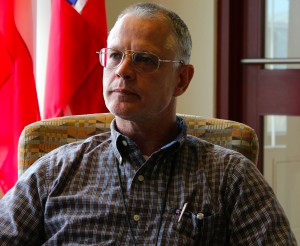07/18/2011 During the Second Line of Defense visit at Pax River in June, we sat down with Leslie Taylor, from the Mission Systems Flight Test group of the Joint Strike Fighter Office in the Naval Air Warfare Center Aircraft Division at Pax River and discussed what the F-35 mission systems bring to the table for the evolution of air combat capabilities.
SLD: We have written about the F-35 combat systems enterprise and have done a recent interview with a Northrop Grumman participant in the effort to build this enterprise.
This aircraft really is a flying combat system, and the mission systems approach allows the aircraft to reverse the traditional logic of adding sensors to the platform to give capability. Now with the F-35, the machine processes data and simply treats sensors as data providers. Can you comment on this development?

Taylor: You hit the nail on the head. The F-35 only uses the sensor part of a sensor suite. Whereas legacy aircraft use the entire sensor suite and integrate that to the platform, the F-35 provides all the processing power behind the sensor, eliminating the requirement to integrate the entire sensor suite onto the aircraft.
By using this method of integration, we basically make the F-35 platform open architecture thus allowing us to upgrade the sensor or even replace the sensor without having the weight and space limitations associated with integrating a newer upgraded system onto the platform.
SLD: So the F-35 is a deployed decision-maker from the mission’s systems point of view? And this allows you to draw the advantages from a dynamic development capability of future sensors wherever they are deployed?
Taylor: Right. And the communication system –the MADL [multifunction advanced data link] – is an important part of this capability. The F-35 removes the ambiguity from the pilot’s decision making process and doesn’t require the pilot to think about what he or she sees. That’s because the fusion engine has already made the determination that the inputs from Radar, EW, and CNI are the same target and displays the information appropriately.
This is fusion in the true sense of the word. It reduces the pilot’s workload and allows him or her to focus more on the mission. Rather than trying to sort through the sensor inputs and derive a solution, the F-35 has already done this.
SLD: Where have you done the testing of the systems to date?
Taylor: We’ve done testing with the mission systems test aircraft and in the labs and on the CATBird [Cooperative Avionics Test Bed]. By having multiple places for testing, we are able to further mature the system prior to implementation onto the F-35. The original concept was to have the Labs and CATBird software and hardware testing well ahead of the F-35 implementation. That unfortunately has not held true but the system maturity we are seeing on the F-35 is largely due to the work being accomplished in the ground and flying labs.
SLD: Obviously you view the mission systems you are testing as a game changer, and require shaping new combat understanding of what a manned aircraft can bring to the party.
Taylor: Nobody has ever brought this kind of a platform to the war fighter; we are now bringing 5th generation sensor capabilities to a Low Observable platform for the Marines and the Navy. This will change not only tactics but how we deploy the assets we have in the global spectrum warfare.
SLD: What is your thinking about the whole Aegis and F-35 relationship?
Taylor: The F-35 is another sensor for Aegis and Aegis is another sensor for the F-35. If we can see 2000 miles out because we have connected eyeballs out there, then the pilot can make better real time decisions on how to employ the assets he or she can bring to bear as well as the Fleet Commander being able to assess the situation to make better long term tactical decisions
SLD: So your point is your baseline, your bedrock, is your processing power, your computational power, your ability to manage data, and then the question of the sensors is simply the eyes streaming that data back to the processor, to the brain.
Taylor: The platform is required to be smart enough to provide the pilot situational awareness with confidence. That information either comes from onboard or off-board sensors, plus the aircraft is sharing that information real time with four or six other platforms that are also in the air and on the ground.
The faster we do the fusion, the real-time sharing, and the more platforms and sensors we bring to solve the problem allows the pilot to take the correct action faster. It’s about more timely and more accurate decision making – that’s what the mission systems of the F-35 are really all about.


